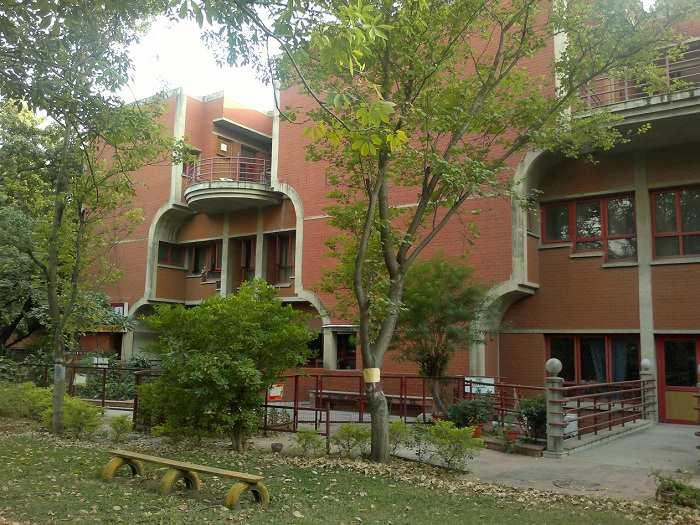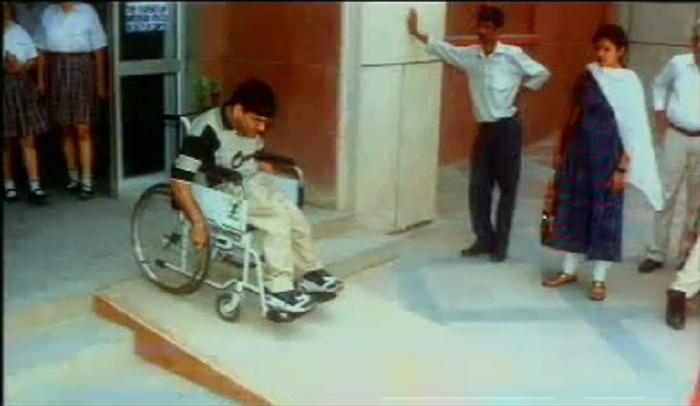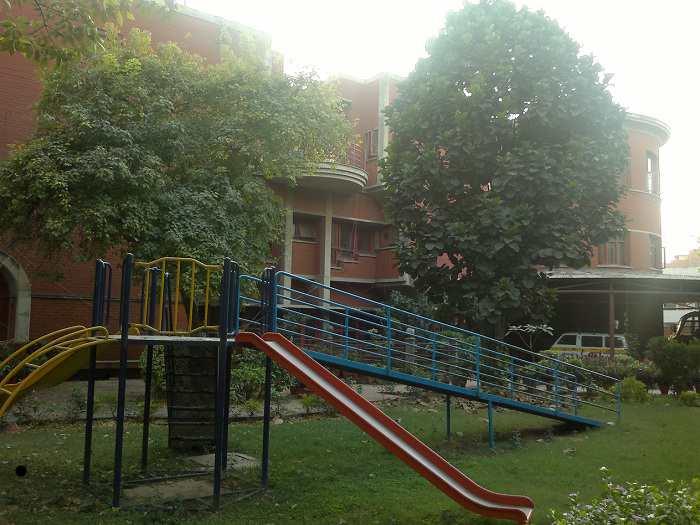[ID:283] AADI-Beginning of a Journey Towards InclusionIndia "I discovered early that the hardest thing to overcome is not a physical disability but the mental condition which it induces. The world, I found, has a way of taking a man pretty much at his own rating. If he permits his loss to make him embarrassed and apologetic, he will draw embarrassment from others. But if he gains his own respect, the respect of those around him comes easily." -- Alexander de Seversky (1894 - 1974)
It was the first time that I had set foot on the campus of AADI, yet I felt at home. The familiarity shocked me; the shock turned to bewilderment and finally metamorphosed into a smile on my face. The smile had its origin in the sweet realization of the fact that the campus of AADI resembled that of my high school. This I had not expected. I had heard about AADI, read about it, followed and appreciated its work but never in my wildest thoughts had I imagined its architecture to be similar to that of my school. I had expected it to be, well, peculiar. Yet, there it was, betraying my imagination, with its unpredictably akin architecture!
AADI (Action for Ability Development and Inclusion) School is run by a Delhi based non-governmental organization, in a posh neighborhood of New Delhi, which has been constantly working for the integration of children with cerebral palsy in the society. Recently, the school has expanded its scope beyond cerebral palsy to include children with multiple disabilities also. It was designed by renowned Indian architect, Romi Khosla, in the year 1995. The building holds the distinction of being the first custom-design school for the physically challenged. The school envisions a world “in which people with disability are an integral part of society, participating in the community and living life to the fullest, with equitable access to opportunities and services enabling them to live life to the fullest.” The design of AADI expedites that vision in an effortless way and, moreover, it stands as a glaring specimen of a rare brand of architecture.
While architecture today is being viewed by many as solely a profit-making industry, replete with extravaganza and splendor, rather than a humble profession which aims at serving the masses, it still remains a powerful means of carving out civilized societies out of raw ones. Civilization, in turn, calls for efforts directed at inclusion of the entire populace within the societal fabric with rightful access to services, development & opportunities to everyone. Architecture that is inclusive in nature, therefore, occupies the highest pedestal in serving the society.
Upon entering AADI, the first thing that strikes you, as mentioned earlier, is its seemingly ubiquitous design[see Photo 1]. Should not a space that caters to people with different abilities have a distinct design? How else does it claim to be a dedicated space for the disabled? On deeper inspection, however, I found that the design was in fact different; but those differences were almost invisible from the outside. Invisibility, here, does not imply that you cannot see the architectural features that have been incorporated specifically for the disabled. Rather, it has been used in a sense to convey that all these features blend seamlessly with the rest of the space. It did, of course, provide barrier free access to all its corners but it did so without swaggering about it. These features do not come across as an oddity in the overall design but, on the contrary, strengthen its aesthetic appeal. What a stroke of brilliance!
In my interactions with people who are disabled one thing became absolutely clear to me: They do not want the sympathy of the society. Nor do they crave for the society to lend its support to them. All they ask is for an equitable chance and access to be a part of the society, for the society to accept them as a part of their own. This, in their words, would enable them to be productive citizens who are neither a burden on the society, nor passive bystanders but active participants who discharge “equal duties” for the development of the society. This profound articulation by the disabled people stems from the deeply ingrained sense of dignity that I found common in all of them. In this regards, the architecture of AADI is an expression of their innermost desires. Elucidating further, when features that are specifically meant for the disabled add to the beauty of the space rather than being a ‘burden’ and marring its aesthetic appeal, it acts a mirror which reflects the potential role of the ‘differently-abled’ can play in the society. Architecture, in this case, becomes a source of inspiration. And if architecture that, in addition to fulfilling a very important role in creating an equitable society, inspires does not qualify as social architecture then what does! This, to my mind, should act as a cornerstone of architecture that attempts to be inclusive.
Inclusion is not a phenomenon that can be thrust upon a populace or even on its small segment; it has to be experienced from within. The best we can do as a society is to facilitate that indigenous aspiration in whatever way possible and try to tackle the inertia that hinders the manifestation of that aspiration into reality. The inclusion of African-Americans in the fabric of the American society comes to mind and so does the on-going struggle of the Dalits (lower caste people), in India, to be an equal, integral part of the Indian mainstream register itself as an example. Attempts made by the higher castes, although few and far between, to integrate the Dalits within the society have been rendered unsuccessful because of their, perceived or otherwise, condescending nature. However, significant advancements have been achieved in augmenting the place of Dalits as equals in society when the so-called upper class acts as just a facilitator of that change and let the Dalits be in the driver's seat. In the same vein, the integration of the disabled can only be achieved when they are psychologically ready for that change. Inclusion should not be forced but enthused by acting as a stimulus. Architecture that is universal, as is the case with AADI, can act as a remarkable stimulus in the process of inclusion of spastic children within the society by boosting their confidence and not creating within them a sense of marginalisation.
Marginalization of the disabled people is a disgraceful reality. In India, as in other developing nations, the disabled, among other sections of the society, have been facing a greater extent of stigmatisation. Negligent architecture and a generic apathetic mood also play a pivotal part in the advancement of this vice. However, the picture is not entirely gloomy and certain examples stand out as sources of inspiration to utilise architecture for the common good, and in this particular case for the betterment of spastic children. Many a times, though, discrimination against the disabled is not deliberate but impulsive. This happens because the society is conditioned to the treatment of disabled in that way so much that it does not even feel that it is indulging in any misdoing. An analogous case would be the suppression of women in a patriarchal society; even the most noble of men in such societies can act as a perpetrator of subdual of women because he does not consider it to be a deed of discrimination. Discrimination of this kind is more dangerous as it is more difficult to be identified, isolated and tackled with. While many constitutional reforms have been made to improve the condition of disabled people like “The Persons with Disabilities (Equal Opportunities, Protection of Rights and Full Participation) Act 1995” they have failed to change the bigger picture. The problem lies not with the reforms but with their implementation. While there is hope that in the coming future the acts and forms of discrimination against the disabled would subside and they will be integrated as equal citizens, the current situation is far apart from that. Consequently, often, in the course of their lives, the disabled are faced with situations which are not conducive to them. These unfavourable scenarios may include simple things, as lack of a ramp or an elevator in a building. This makes it necessary to ensure that the disabled do not grow up in an overly protected environment which would make it very difficult for the disabled to overcome such barriers later, if and when faced with, in life.
The architecture of AADI, in this respect, adopts a very pragmatic approach. In addition to providing hassle free medium of movement for the disabled it also has included common barriers like a staircase and encourages the disabled to climb them [see Photo 2] , occasionally, so that a future encounter would not render them incapacitated in respect to tackling them. Once the disabled get used to such an activity they are able to pull it off by themselves. However, in the beginning the disabled are motivated, and guided, to undertake independent movements [see Photo 3]. Help is provided wherever need be. Architectural design, in addition to being inspiring, can, thus, retain its pragmatism- which it does at AADI. This type of architecture is best suited for serving the masses.
AADI has ample space allocated as a playground. The playground includes swings as are commonplace in any school. The swings and slides are also custom-designed for the disabled just like everything else at AADI [see Photo 4]. The presence of a playground adds charm to the lives of the disabled and acts as a source of entertainment. With the introduction of specific games for the disabled, the playground achieves even greater significance. The disabled can go on to become athletes or sportsmen and win laurels for themselves and the nation. However, in most cases, due to practical considerations, the field chosen, as a career, by the disabled is either related to arts or academics. In the words of the legendary American theoretical physicist, Stephen William Hawking, who, himself, is physically challenged: “If you are disabled, it is probably not your fault, but it is no good blaming the world or expecting it to take pity on you. One has to have a positive attitude and must make the best of the situation that one finds oneself in; if one is physically disabled, one cannot afford to be psychologically disabled as well. In my opinion, one should concentrate on activities in which one's physical disability will not present a serious handicap. I am afraid that Olympic Games for the disabled do not appeal to me, but it is easy for me to say that because I never liked athletics anyway. On the other hand, science is a very good area for disabled people because it goes on mainly in the mind. Of course, most kinds of experimental work are probably ruled out for most such people, but theoretical work is almost ideal. My disabilities have not been a significant handicap in my field, which is theoretical physics. Indeed, they have helped me in a way by shielding me from lecturing and administrative work that I would otherwise have been involved in. I have managed, however, only because of the large amount of help I have received from my wife, children, colleagues and students. I find that people in general are very ready to help, but you should encourage them to feel that their efforts to aid you are worthwhile by doing as well as you possibly can.” In facilitating such a path for its students, AADI has an advantage due to its location. It is only a few hundred meters away from the best engineering institute of India (IIT). Moreover, the best medical institute of the country (AIIMS) also lies nearby. Their vicinal location can be advantageous in facilitating contact between the resident scholars of these institutes and the students of AADI on a regular basis. These interactions can help in cultivating an intellectual environment within the student community at AADI and, thereby, enabling them to grow and excel in those fields and have independent, fulfilling lives for themselves and also contributing to the society and humanity as a whole.
AADI, in Sanskrit, means ‘beginning’. AADI, aptly, boasts of an initiative that has begun the process of inclusion of the disabled within the central realms of the society. Despite the fact that a lot remains to be done in tackling the largely overlooked tragedy of exclusion and stigmatization of the disabled, AADI has come a long way in realizing its stated goals. Originating from humble roots the organization is in a position wherein it is able to spread awareness regarding the vice, and mold the designs of public infrastructure. This process has been facilitated by the exemplary architecture which not only has its roots in pragmatism but also excites, inspires, and serves the public.
On leaving AADI after I had visited it for the first time, I headed to the nearest Metro station- Green Park Metro Station – of the Delhi Metro Rail Corporation. It falls on the opposite side of the road, some 500 meters away. When I reached the station I noticed a dropped-curb that led to an elevator which headed to the underground platforms. The elevator along with the dropped-curb, of course, was meant for the disabled and the elderly to be able to commute without any difficulty. The Metro Line had been recently laid in Delhi. In the rush of travel such ‘non-related’ stuff usually did not register as being important to take cognizance of. But, that time, observing the architecture of that particular station, in light of what I had experienced at AADI, for the first time, I was pleased to see that our public architecture, at least, had matured over years and become inclusive. The vicinity to AADI gave me a feeling, perhaps reasonably, that this maturity was a result of the inspirational architecture of AADI itself. And then, to my amazement, I observed that such facilities had been provided at all the metro stations that I have been through since then. AADI, on merit of its initiative and social architecture, had played a sensibly pivotal role. Some beginning, indeed!
If you would like to contact this author, please send a request to info@berkeleyprize.org. |




